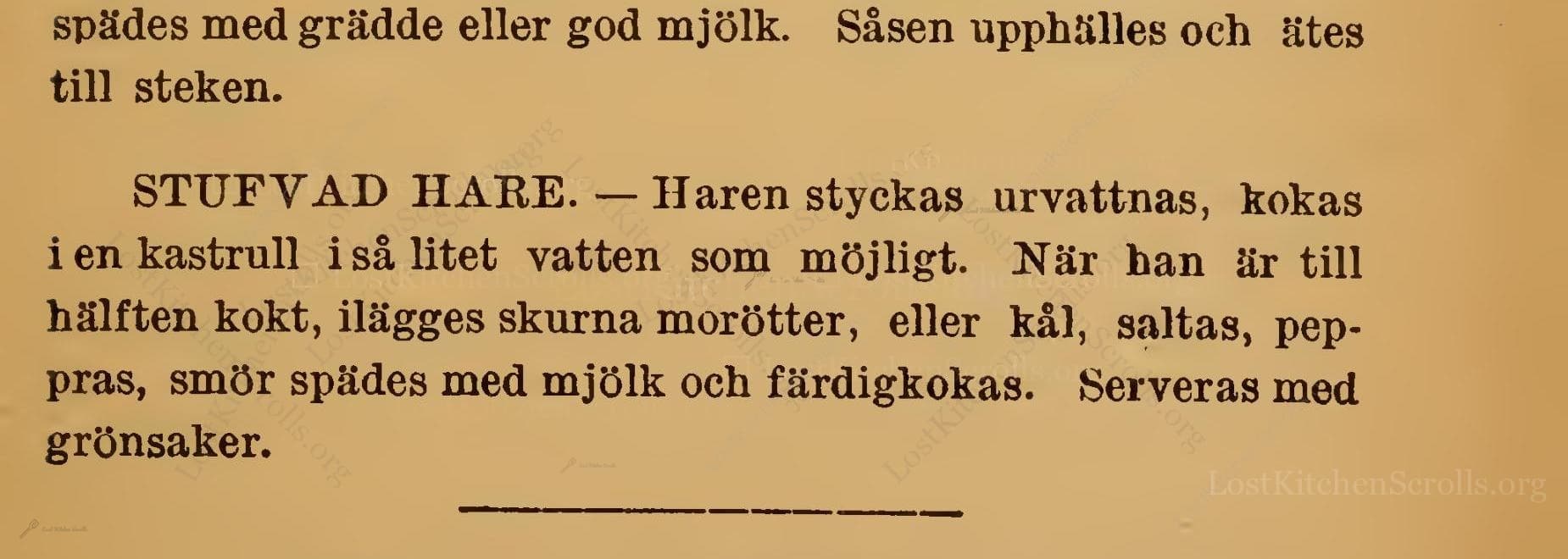Stufvad Hare
"Stewed Hare"
From the treasured pages of Praktisk, illustrerad kok-bok för Svenskarne i Amerika
Written by C. A. (Charles A.) Vallentin

Stufvad Hare
"Haren styckas urvattnas, kokas i en kastrull i så litet vatten som möjligt. När han är till hälften kokt, ilägges skurna morötter, eller kål, saltas, peppras, smör spädes med mjölk och färdigkokas. Serveras med grönsaker."
English Translation
"The hare is cut up, soaked, and cooked in a pot with as little water as possible. When it is half-cooked, add sliced carrots or cabbage, salt, pepper, and butter, thinned with milk, and finish cooking. Serve with vegetables."
Note on the Original Text
Written in Swedish, the recipe is presented in a concise, utilitarian manner, typical of 19th-century cookbooks—intended for home cooks familiar with the basics. Quantities are vague, reflecting both limited measuring tools and reliance on the cook's judgment. 'Stufvad' is an older spelling of 'stuvad,' meaning stewed or simmered, and spelling conventions, as well as culinary expectations, have evolved since then. Instructions assume the reader understands processes such as cleaning, jointing, and simmering game meat, omitting details more explicit in modern recipes.

Title
Praktisk, illustrerad kok-bok för Svenskarne i Amerika (1889)
You can also click the book image above to peruse the original tome
Writer
C. A. (Charles A.) Vallentin
Era
1889
Publisher
Svenska bok-och musikhandelns förlag
Background
A practical and charmingly illustrated Swedish cookbook tailored for immigrants in America, this 1889 volume serves up a delightful array of recipes and culinary wisdom, blending Old World tradition with New World ingredients.
Kindly made available by
Library of Congress
This recipe for 'Stufvad Hare' comes from the 1889 practical, illustrated Swedish-American cookbook by Charles A. Vallentin, published in Minneapolis. Envisioned for Swedish immigrants in America, the cookbook bridges traditional Swedish recipes with the realities of new-world ingredients and kitchen practices. At the time, hare and other game meats were readily available, especially for settlers and homesteaders. The gentle stewing in minimal water, enriched by butter and milk, reflects both the need to be economical with resources and the Swedish taste for softer, milder stews. Cooking was often done over wood stoves or open hearths, where resourcefulness and adaptability were prized. This recipe connects to a time when meals made use of what was available, with an eye both to frugality and comfort.

The recipe would have been prepared using basic tools of the late 19th-century kitchen. A large cast iron or enameled stew pot ('kastrull'), wooden or metal ladles, and knives for jointing the hare and slicing vegetables would all be fundamental. Cooking took place on a wood-burning stove, where maintaining a gentle simmer required skillful adjustment of dampers and fuel. No measuring spoons—'a pinch' or 'as much as needed' ruled the day, and cooks judged doneness by eye and experience.
Prep Time
25 mins
Cook Time
1 hr 10 mins
Servings
6
We've done our best to adapt this historical recipe for modern kitchens, but some details may still need refinement. We warmly welcome feedback from fellow cooks and culinary historians — your insights support the entire community!
Ingredients
- 1 whole hare (about 3¼–4½ lb), or substitute with rabbit
- 2 cups water (enough to barely cover the meat)
- 2 medium carrots (7 oz), peeled and sliced, or 7 oz white cabbage, chopped
- 1-2 teaspoons salt (to taste)
- ½ teaspoon black pepper (to taste)
- 3½ tablespoons unsalted butter
- 1 cup whole milk
Instructions
- Begin by jointing and cleaning a whole hare (or use rabbit as a substitute).
- Soak the meat in cold water for several hours to remove excess blood and impurities, changing the water if necessary.
- Place the pieces in a large pot and pour in just enough water to barely cover the meat—about 2 cups.
- Bring to a gentle simmer and cook for about 30 minutes.
- When the hare is halfway cooked, add in peeled and sliced carrots (about 2 medium carrots, 7 oz) or substitute with equal weight of chopped white cabbage.
- Season with salt (1-2 teaspoons) and black pepper (about ½ teaspoon, or to taste).
- Add 3½ tablespoons butter to the pot, then pour in about 1 cup whole milk.
- Continue cooking at a gentle simmer until the meat and vegetables are tender, about 30-40 minutes.
- Serve the stew hot, ensuring each portion has plenty of both meat and vegetables.
Estimated Calories
400 per serving
Cooking Estimates
Preparing the hare or rabbit, slicing vegetables, and measuring ingredients takes about 25 minutes. Cooking the stew takes about 1 hour and 10 minutes. Each serving has around 400 calories. This recipe serves 6 people.
As noted above, we have made our best effort to translate and adapt this historical recipe for modern kitchens, taking into account ingredients nowadays, cooking techniques, measurements, and so on. However, historical recipes often contain assumptions that require interpretation.
We'd love for anyone to help improve these adaptations. Community contributions are highly welcome. If you have suggestions, corrections, or cooking tips based on your experience with this recipe, please share them below.
Join the Discussion
Rate This Recipe
Dietary Preference
Main Ingredients
Occasions

Den Bockfisch In Einer Fleisch Suppen Zu Kochen
This recipe hails from a German manuscript cookbook compiled in 1696, a time whe...

Die Grieß Nudlen Zumachen
This recipe comes from a rather mysterious manuscript cookbook, penned anonymous...

Ein Boudain
This recipe comes from an anonymous German-language manuscript cookbook from 169...

Ein Gesaltzen Citroni
This recipe, dating from 1696, comes from an extensive anonymous German cookbook...
Browse our complete collection of time-honored recipes



